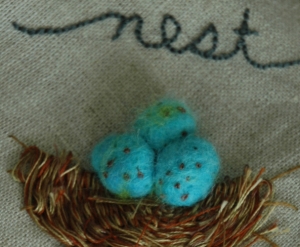Wednesdays are a good day for science. We’re not sure why, but they are. After piano lessons and supper, spending an hour or two digging our hands into some science experiment or another is just plain fun.
Last night, we played with these:

It’s a polymer known as polyacrylamide, and it is tons of fun. Polyacrylamide is often used in soft contact lenses and test tube aliens and those animals you throw in the bathtub and watch them grow. Straight out of the package, it looks like this:

Tiny, hard balls maybe 2 mm in diameter. They sure don’t look like much, do they? The amount in the picture above is about a tablespoon worth. Where it gets interesting is when you add water and let them soak for a few hours. See?

What do you mean, you don’t see anything. There’s about a teaspoon of polyacrylamide beads in there. Can’t you see them? Here’s another view:

In the corner, you can see the original package, to get an idea of the scale of things. The cup measure, by the way, is a 4 cup measuring cup. It’s big.
Last night, about half an hour after putting the beads in the water, they had grown to about half a centimeter in size and had the texture of raspberries. They’re bouncy too, and slippery, and escape rather quickly if you aren’t paying attention. The kids were fascinated and kept dipping their hands in the water to play with them. So we talked about polymers and how these particular polymers absorb water, then slowly release it again as they dry out, and how they are great in the garden for helping keeps plants moist even in a hot sun. But bedtime comes early — too early, perhaps, when there is a science experiment in progress on the kitchen counter — and they went off to bed with visions of transparent raspberries floating around their heads.
Come morning, the first reaction was “where did they go? Mom! Did you throw them out?” Because, you see, the big measuring cup looked empty from across the room. Well, not empty exactly, but full of nothing but water.
When you get your hands dirty, when you stick your fingers right down into the water and feel around, you find the polyacrylamide beads are still there… but they’ve grown. A lot. Here’s what it looks like when you pour all the water out of the measuring cup:

And when you pick them up, you find they are smooth and round and still somewhat bouncy, and definitely slippery! And much, much bigger than they were last night.

“But why couldn’t I see them?” was the next question before breakfast, and that led to a lot more experimentation. We learned about the index of refraction, and bent a pencil in a cup of water, than cut a spoon in half only to have it magically be whole again when you remove it from the glass. The science of light and how it behaves is a fascinating thing indeed.
From there we went off to youtube and watched Steve Spangler explain it. (For some reason, I can’t get the video to embed itself properly today, so you’ll have to click the link to watch it).
Watching him do it gave us a few ideas for more things to do. First came the secret messages, and then out came the food colouring.

You can see the unexpanded beads sitting in the bottom of each glass. We’ll let you know how it turns out.

I love the jelly beads they are lots of fun! I made some the other day and they don’t have full colour so they just look like a bunch of stripes on a ball, more like a marble they are great for display! I have hundreds of them in my bathroom bedroom etc. Everyone comments on my work they say that they grow so quick! Or that they look great in display and mostly the question asked was where do you get them from? I’ve made my own website all about them. They are great for mixing colours. I am 11 And I know that making a website is a bit advanced for my age. But I don’t just like to hang around on my mobile all day! I like experimenting and going skateboarding too and playing rugby and soccer. But one day I came home from school and I found that one of my jelly beads had a tiny crack in it and another jelly bead too! Then in my hands one of the jelly beads was opening and once it opened there was another little jelly bead inside! Which I thought was really strange. I have been researching ever since and the same thing is happening to my other ones. Thanks for posting these pictures and doing a digraph on them.- sincerely Emma Kalaitzoglou ( QLD ) Australia
LikeLike